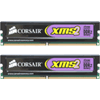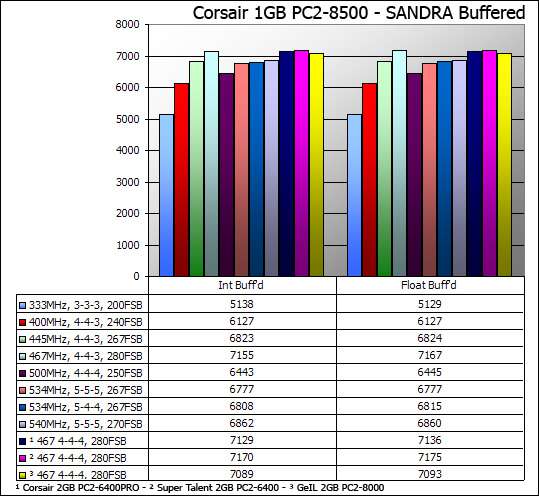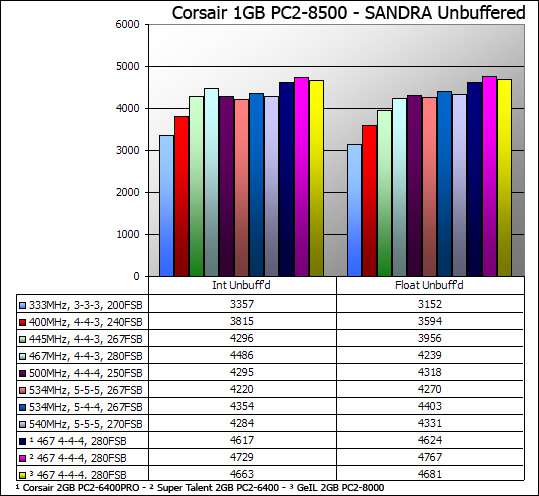- Qualcomm Launches Snapdragon 4 Gen 2 Mobile Platform
- AMD Launches Ryzen PRO 7000 Series Mobile & Desktop Platform
- Intel Launches Sleek Single-Slot Arc Pro A60 Workstation Graphics Card
- NVIDIA Announces Latest Ada Lovelace Additions: GeForce RTX 4060 Ti & RTX 4060
- Maxon Redshift With AMD Radeon GPU Rendering Support Now Available
Corsair 1GB TWIN2X1024-8500

Without a doubt, DDR2 memory is becoming increasing popular, especially with an AM2 launch coming up. Corsair has given us some memory that’s worth talking about. While it’s only a 1GB kit, it’s the fastest 1GB kit you can get your mitts on.
Page 3 – Testing Procedures & Sandra
On this page, I will explain how our testing procedures go. Firstly, the hard drive that hosts the operating system is fully defragged using Diskeeper 10 to assure no hiccups will be due to the OS. All testing occurs on a standalone OS installation that’s dedicated to testing. Second, all unnecessary programs in Windows are closed down, minus the essential ones. This includes virus scanners, firewalls, peripheral software, etcetera. Before any testing occurs, the memory goes through a 4 hour MemTest run at stock settings to assure that they are error free and appropriate for overclocking and benching.
To test out the modules, I used the usual variety of benchmarking tools. No games are included in our memory benchmarking, because I consider them to be a waste of time. Overclocking your memory generally means overclocking your CPU in conjunction, which makes it hard to diagnose just what kind of difference the memory made. Here is the selection of tools we use in the review:
- Futuremark 3D Mark 2001
- Futuremark PC Mark 2005
- Lavalys EVEREST 2005
- MemTest 1.65+
- Sciencemark 2
- SiSoftware SANDRA 2005
- Super Pi 1.5 Mod
- Test System
- CPU: Pentium D 820 @ 2.8GHz
- Motherboard: ASUS P5WD2-E Premium w/ 401 BIOS
- Memory: Corsair 1GB PC2-8500
- Video: BFG 6800GT OC 256MB PCI-E
- Sound: Realtek HD Audio
- Storage: WD 200GB 7200 8MB
- Odds and Ends: D-Link WiFi PCI Card
- Etcetera: Windows XP Professional SP2, Windows x64 Professional SP1, NVIDIA 81.98 Drivers
Throughout all of our graphs, you will see this structure: “400MHz, 4-4-3-8, (200)”. The number in the parentheses is the FSB while the MHz is the frequency of the memory. Multiply that frequency by 2 and that’s how you will acquire the DDR2-800 speed.
SANDRA is by far one of the most popular memory benchmarking tools out there, and for good reason. The reason I personally like it, is because you have the option of tweaking countless settings in order to benchmark to your liking. I run benchmarks using default settings in addition to unbuffered.
The scores are right up to par with what I expected. As usual, DDR2-933 was the best performer, due to my CPU not being able to go far beyond 280FSB. The unbuffered favored the 2GB kits, obviously due to the extra bandwidth.


|
|
Support our efforts! With ad revenue at an all-time low for written websites, we're relying more than ever on reader support to help us continue putting so much effort into this type of content. You can support us by becoming a Patron, or by using our Amazon shopping affiliate links listed through our articles. Thanks for your support!





